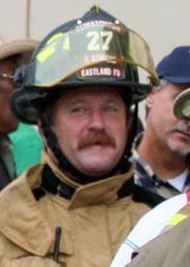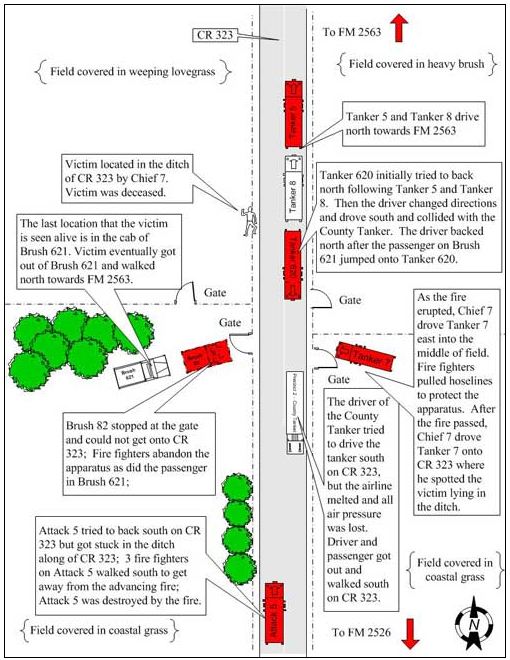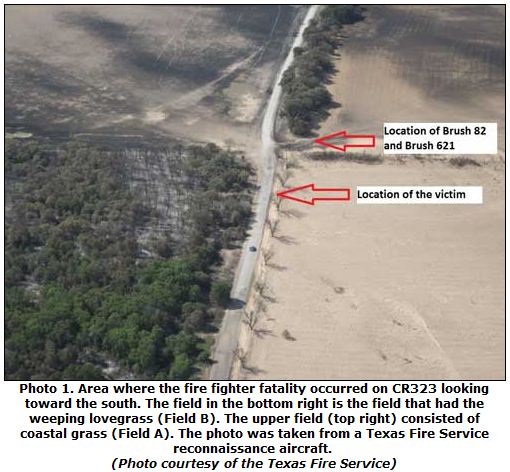
In April, 2011, Wildfire Today covered the Line of Duty Death of firefighter Greg Simmons on a fire at County Road 323 near Gorman Texas. The fatality occurred as 10 fire vehicles were attempting to escape from a vegetation fire and became bottle-necked at a gate. Mr. Simmons was found deceased in a roadside ditch along CR 323 with severe burns on his head and upper body. He was wearing bunker pants, fire-fighting boots, and a tee shirt. The coroner determined that the cause of death was blunt force trauma from either being struck by or run over by a fire vehicle during fire-fighting operations in smoky conditions with very limited visibility.
The report that NIOSH released has more details, of course, and here are some excerpts. (Mr. Simmons had been working on Brush 621.)
=====================================================
“…As the three fire fighters from Brush 82 and Brush 621 attempted to outrun the fire on foot on CR 323, they were able to jump into or onto Tanker 620. Due to the volume of vehicles attempting to escape the fire, the poor visibility due to the smoke, as well as a variety of tanker mechanical issues resulting from the intense heat, fire fighters were driving their tankers off the road, frequently colliding with each other, blocking each other in, and, as a result, many had to escape the fire by backing out (using the edge of the road as a guide as it was not possible to see the road). Tanker 7 did not escape on the road, but rather drove into a field east of CR 323. Tanker 7, operated by Chief 7, with two other fire fighters, was in the field of coastal grass on the east side of CR323 when the fire erupted. Chief 7 drove Tanker 7 east into the field approximately 100 yards and parked. The three fire fighters each deployed a hoseline to protect the apparatus and themselves. They operated in this mode for approximately 5–10 minutes until the fire passed them.
All of the remaining fire fighters on the tankers and the three fire fighters from Brush 82 and Brush 621 were able to escape the fire; however, five other fire fighters suffered burns during their escape. Many of the fire fighters were not wearing any type of personal protective equipment (PPE). One brush truck was completely destroyed after it became stuck in a ditch; however, the fire fighters were able to escape and walk to safety before the apparatus burned. Three other tankers and one brush truck also incurred damage to their air brakes, lights, hoses, and/or other equipment due to the intensity of the fire.”

Contributing Factors
- Ineffective incident management
- Ineffective personnel accountability system
- Lack of situational awareness
- Lack of common radio frequency
- A safety zone and escape route were not effectively communicated to all fire fighters
- Failure to use a fire shelter from the approaching fire
- Weather conditions.
Key Recommendations
- An Incident Management System should be used to manage wildland urban interface incidents
- The Incident Commander should use division/group supervisors to ensure effective tactical level management
- A personnel accountability system should be used to account for all fire fighters and first responders assigned to the incident
- Fire departments should ensure that the communication system meets the requirements for daily and complex incidents
- Lookouts, communications, escape routes, and safety zone (LCES) should be established and used at each wildland incident
- Provide fire fighters with approved fire shelters and provide training on the proper deployment of the fire shelters
- Fire fighters who engage in wildland fire-fighting should use personal protective equipment which meets NFPA 1977, Standard on Protective Clothing and Equipment for Wildland Fire Fighting
- Fire fighters who engage in wildland fire-fighting should be trained to meet the minimum training requirements as required by the National Wildfire Coordinating Group (NWCG) or NFPA 1051, Standard for Wildland Fire Fighter Professional Qualifications
- Fire departments and fire service agencies should ensure that fire fighters fully comply with “The 10 Standard Fire Orders “and are aware of the “18 Watchout Situations” and “Common Denominators of Fire Behavior on Tragedy Fires.”
Additionally, states, municipalities, and authorities having jurisdiction should consider requiring mandatory wildland fire training for fire fighters.”
Thanks go out to Justin


